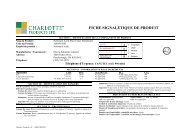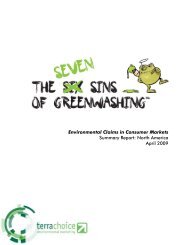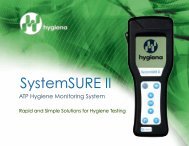company overview and product reference ... - Enviro-Solutions
company overview and product reference ... - Enviro-Solutions
company overview and product reference ... - Enviro-Solutions
- No tags were found...
Create successful ePaper yourself
Turn your PDF publications into a flip-book with our unique Google optimized e-Paper software.
Why Choose Green?Why Choose Green?W H Y T H E D E M A N DF O R G R E E N ?W H A T Y O U C A N ’ T S E EC A N H U R T Y O U . . .63%10The hazards of continuing to choose traditional cleaning chemicalsare increasing risks to the health <strong>and</strong> safety of yourself, your cleaningstaff, <strong>and</strong> all your building occupants. In addition, you are contributingto the widespread damage to the environment for future generations.In a survey of 32 facilities in Richmond, California regarding250 janitorial <strong>product</strong>s in use revealed that:• 7% should not be used as they could cause cancer or werevery damaging to the environment• 56% require extreme care as the ingredients can causeblindness, severe skin damage, interfere with the endocrinesystem, or be absorbed through the skin or inhaled <strong>and</strong>subsequently cause damage to the blood, liver, kidneys,nervous system, or a developing fetus.In all likelihood a similar survey conducted in your area wouldyield very similar results.H O W A R E P E O P L E A F F E C T E D ?1)Direct Contact by Cleaning Staff -Janitorial workers experience relatively high injury rates,such as headaches, asthma, burns, permanent eye damage,major organ damage <strong>and</strong> even cancer.2)Indirect Contact by Users of the Facilities -By sitting on or touching items cleaned, by way of absorptionof the residue the chemicals have left behind.3)Poor Indoor Air Quality -Chemicals affect IAQ, which in turn affects all buildingoccupants in a variety of ways.Some Examples of Concern:• 2-butoxyethanol, a common ingredient in cleaning <strong>product</strong>s,is a toxin suspected of causing learning disabilities in childrenas well as liver <strong>and</strong> kidney damage.• A fetus may come into contact with an endocrine-disruptingchemical, but problems, such as birth defects, infertility <strong>and</strong>learning disabilities may not show up until much later.D I D Y O U K N O W ?POO R I N D OOR A I R Q U A L I T Y• Poor quality indoor air can produce health effects in occupantsranging from headaches <strong>and</strong> dry eyes to nausea, dizziness <strong>and</strong>fatigue; <strong>and</strong> the possible development of asthma <strong>and</strong> multiplechemical sensitivity.• These health effects contribute to increased absenteeism/sickdays, low morale <strong>and</strong> decreased worker <strong>product</strong>ivity <strong>and</strong> creativity.• Indoor air quality is ranked among the nation’s top5 environmental risks. IAQ can be 2 to 100 times worse thanthe outdoors.• The World Health Organization estimates that 30% of allbuildings in North America experience IAQ problems.• Various studies of school districts found that there was a directcorrelation between Indoor Air Quality <strong>and</strong> both attendance <strong>and</strong>performance of their students, as well as attitudes <strong>and</strong> behaviours.• Much of the dramatic increase in asthma among school-agechildren is the result of poor quality indoor air related toinadequate building maintenance, cleaning, <strong>and</strong> exposure tooverly toxic cleaning chemicals.• Multiple Chemical Sensitivities (MCS) occur when a personreacts to chemicals in the environment. These chemicals areusually petroleum based. When a chemical injury occurs, manypeople become "Universal Reactors”. Universal Reactors havesymptoms to a significant number of substances in all categoriesof foods, molds, inhalants <strong>and</strong> chemicals.• Petroleum based chemicals can be found in pesticides, syntheticfragrances <strong>and</strong> cleaning <strong>product</strong>s & detergents. These<strong>product</strong>s are in use with little testing as to health effects onhumans due to the popular view that chemicals are “Safe, UntilProven Toxic”.• Over the past 50+ years, the number of synthetic chemicals has grown from 1.3 billion pounds in 1940to over 320 billion pounds.• Of these, approximately 100,000 chemicals are in use today, but less than a 1000 have been extensivelytested for human health concerns.• There are approximately 2000 chemicals introduced each year that are not regulated.• We currently reside under the “Safe, Until Proven Otherwise” notion. We need to invert this thinking to“Not Safe, Until Proven Otherwise”.www.enviro-solution.com C Choose Wisely...Choose <strong>Enviro</strong> <strong>Solutions</strong>U








